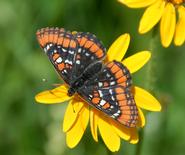
Ernest Williams, the William R. Kenan Professor of Biology, published an article titled “Population Loss and Gain in the Rare Butterfly Euphydryas gillettii (Nymphalidae)” in Journal of the Lepidopterists' Society (66:147-155). This study revealed some of the effects of climate change on living organisms.
For this study, Williams repeated a survey he had done in the 1980s of all known populations of this butterfly. Twenty-five years later, he found that seven of the 14 populations had died out, all because of changes in the vegetation at the sites.
At one site, forest succession had filled in a formerly open meadow, and the habitat no longer provided the resources the butterfly needs. But the vegetation at the other six sites had changed because the habitat had dried out from warming associated with climate change; these six sites occurred with a combination of low latitude and low altitude. In addition to these population losses, a single new population had colonized a high elevation moist site. The results add to our understanding of the biological effects of climate change.
Posted October 18, 2012
